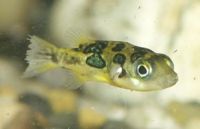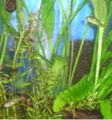Dwarf Puffer (Carinotetraodon travancoricus)
From The Aquarium Wiki
Dwarf Puffer
Carinotetraodon travancoricus
19 Litres (5 US G.)
2.5-3.8cm (1-1.5 ")
Freshwater
7.0 - 8.5
24 -26 °C (75.2-78.8°F)
5-10 °d
1:2 M:F
5-10 years
Family
Tetraodontidae
This animal is available captive bred
Contents
Additional names
- Dwarf Indian Puffer, Dwarf Puffer, Pygmy Puffer, Bumblebee Puffer, Pea Puffer, Blue Eyed Puffer, Malabar Puffer, Indian Malabar Puffer, Malabar Pufferfish
Additional scientific names
- Tetraodon travancoricus, Monotreta travancoricus, Monotetrus trauancoricus
Origin[edit]
- One of the fully freshwater puffers, Dwarf puffers originate from slow moving streams of India in the Malabar region, hence one of the common names.
Sexing[edit]
- Sexing of juveniles is impossible because these fish "choose" their sex as they mature. Once one puffer begins male he excretes hormones to prevent the other puffers from becoming male. However, if two fish start to mature into males at the same time one will become the dominant male.
- Males are smaller with a dark line running down the length of their white belly (not along their sides like some articles say), which is an indication of the ventral crest which erects as part of the courtship behaviour of the fish. The males may also be darker, more subtlety coloured.
- There is also a dorsal crest, but it lacks special colouration when not erected. Both crests are displayed during courtship while the male circles the female. They also will have more yellow colouration. Males will also develop “wrinkles” behind their eyes, that the females do not have.
- Females are more rounded, tend to be a bit larger than males, and may or may not show more smallish spots between their larger dark markings.
Breeding[edit]
- Breeding is preceded by short-term pair formation with display by the male of his dorsal and ventral crests while he circles a gravid (egg-bearing) female. This may be preceded by spawn-site selection by the male, but this may not be obvious to the keeper as these sites are normally in plant thickets (dense growth of stem plants, especially small-leafed ones, or clumps of Java Moss).
- Some nipping and biting by the male may occur as part of the attention-getting display. If the female responds, she will follow the male and finally precede the male into his indicated spawning site, deposit eggs and swim away. The male will follow and fertilize the eggs. This may be repeated several times before the female leaves the area (there should be multiple heavily planted areas available to offer her refuge from overly persistent males).
- The male will guard and fan the eggs until hatching. Females take no further interest or care in the spawn. For such a small puffer, the fry are quite large at hatch and most will take and survive well on newly hatched brine shrimp. Many other puffer fry are much too small for newly hatched brine shrimp. These fish are commercially bred in the USA, and fairly frequently bred and raised by hobbyists.
Tank compatibility[edit]
- Like all puffers, Dwarf Puffers should not be considered community fish and should generally be kept in a single species set-up. They can be very aggressive and territorial, often nip fins, and there are reports of them killing fish larger then themselves.
- There are however a few other fish species that have been found to be respectable tank mates, please remember that even after living peacefully with tank mates for years, no fish is guaranteed safe forever. Tank mates that some have found success with are Otocinclus, Kuhli Loaches, and occasionally shrimp.
- For the experienced fishkeeper, multiples of this species can be kept together if the tank is very well planted and big enough so they are not constantly in sight of each other and well fed. This species develops a hierarchy when in a group, and one puffer (usually a male) will become the dominant one.
Diet[edit]
- Like some puffers, dwarf puffers are snail eaters. Malaysian Trumpet Snails should not be feed, as their shells are too hard, and may break the Dwarf Puffers beak. Small Ramshorn snails are ideal as an easily cultured and highly nutritious food. Dwarf puffers seem unique in this family in that their fused dental plates are very thin (rather like an infant or small child's fingernails) and they do not seem to require the high-crunch factor in their diet that the other hunter-predators in this genus (Carinotetraodon) and their ilk in the Tetraodon genus require. They are biters and slurpers - meaning that they tend to bite into and pull the snails from their shells (as many Loaches do) rather than crushing the shell. Very small and thin shelled snails, such as the small common Ramshorns may be crushed.
- Many have also had success with the addition of frozen, and/or live food to their diet, including blackworms, mosquito larva, tubifex worms, bloodworm, white worm, water fleas, brine shrimp all are excellent additions to their diet.
- Do note that there is no real inconsistency in suggesting shrimp as possible tanks mates, and also shrimp as potential food items. There is much individual personality and many levels of aggression, even within a single genus and species in the puffer family. One individual or group may not recognize shrimp as prey and food. Another individual or group will, without hesitation, capture, dismember, and consume any shrimp dropped into their tank. Accurate individual predictions are impossible, as are long-term bets. Aggression levels do increase at sexual maturity, so the onset of visible secondary sex differences may also mark a change in the tolerance of tank mates or the selection of prey.
- Where live worms are fed, the use of perforated cone feeders is strongly suggested. Dwarf puffers seem to feel it necessary to carefully examine each morsel for suitability. If blackworms are dropped into the tank as group, many to most will escape into the gravel and be uneaten. The cone allows them to work their way out only relatively slowly, giving the fish time to decide that this is food and that it should be taken. Most DPs love blackworms, once they recognize them as food, but they do continue examining each worm individually.
Feeding regimen[edit]
- Feed once or twice a day, no more than can be consumed in a few minutes.
- Puffers, as with many captive fish, have little or no built-in restrictions on quantity of food consumed. In the wild they must seek and search for prey. In captivity food is provided, and more often than not it is provided in excess. Puffers, with their peculiar structure, make it simple to see how much food they have consumed as their gut is not surround by ribs and bands of swimming muscles as in most fish. The appearance of a lightly rounded belly is plenty of food. A fat belly is too much. Overfeeding most captive fish not only increases tank upkeep, over time it shortens the fish's life by liver and or kidney problems and other issues from obesity. The old adage about a lean horse for a long race has application also in the fish hobby.
Environment specifics[edit]
- Fairly easy for an experienced aquarist. Sensitive to water quality issues, regular water changes are a must. Only keep in a fully cycled tank, ammonia and nitrite should be 0. Messy eaters, over filtration is highly recommended.
- Provide with hiding places/caves made from bogwood/driftwood and unglazed ceramic pots. Dwarf puffers should only be housed in a well-planted tank, with many line of sight breaks provided.
Behaviour[edit]
- When this fish is first introduced into your tank you will notice it travels around with its tail curved. This is normal and is a sign of defence. As the puffer ages and becomes used to its environment then this tail curling will disappear other than when sleeping or napping, or when examining an object while keeping it in clear sight directly in front of the fish.
- Known to be fearless and aggressive, they can and will take on fish larger than themselves. Very intelligent, dwarf puffers have been known to recognize their owners, and beg for food. Dwarf puffers will provide hours of entertainment to their owner as they relentlessly hunt for snails. Keeping a large group of 5-6 puffers can help defuse aggression between individuals.
Pictures[edit]
Pictures of the same dwarf puffer (possible female)
Young dp alongside two otocinclus
Videos[edit]
External links[edit]
- Fishbase (Mirrors:
 )
)







